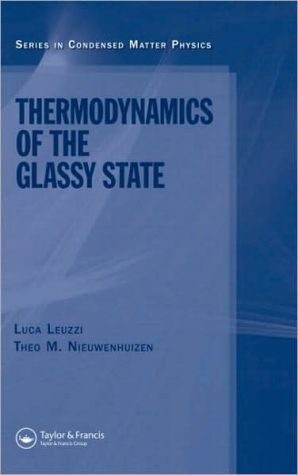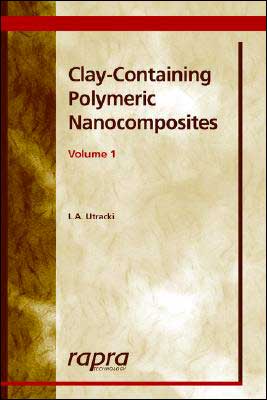Thermodynamics of the Glassy State
In the past thirty years, the area of spin glasses has experienced rapid growth, including the development of solvable models for glassy systems. Yet these developments have only been recorded in the original research papers, rather than in a single source. Thermodynamics of the Glassy State presents a comprehensive account of the modern theory of glasses, starting from basic principles (thermodynamics) to the experimental analysis of one of the most important consequences of...
Search in google:
In the past thirty years, the area of spin glasses has experienced rapid growth, including the development of solvable models for glassy systems. Yet these developments have only been recorded in the original research papers, rather than in a single source. Thermodynamics of the Glassy State presents a comprehensive account of the modern theory of glasses, starting from basic principles (thermodynamics) to the experimental analysis of one of the most important consequences of thermodynamics-Maxwell relations.After a brief introduction to general theoretical concepts and historical developments, the book thoroughly describes glassy phenomenology and the established theory. The core of the book surveys the crucial technique of two-temperature thermodynamics, explains the success of this method in resolving previously paradoxical problems in glasses, and presents exactly solvable models, a physically realistic approach to dynamics with advantages over more established mean field methods. The authors also tackle the potential energy landscape approach and discuss more detailed theories of glassy states, including mode coupling, avoided critical point, replica, and random first order transition theories.This reference lucidly explores recent theoretical advances in the thermodynamics of slowing-aging (glassy) systems. It details the general properties of glassy states while also demonstrating how these properties are present in specific models, enabling readers to thoroughly understand this fundamental yet challenging area of study.
Preface VAcknowledgements VIIAcronyms XISymbols XIIIIntroduction 1Theory and phenomenology of glasses 15Processes, timescales and transitions 15Dynamical glass transition 17Thermal glass transition 19Strong and fragile glass formers 23Aging 26Time sector separation 28Configurational entropy 29Kauzmann paradox 30Static phase transition and Kauzmann temperature 31"Classic" versus "modern" configurational entropy 31An intrinsically dynamic "state" function 33Adam-Gibbs entropic theory 34Absence of flow in cathedral glasses 37Fragility index 38Kovacs effect 39Two temperature thermodynamics 43Elements of thermodynamics 46First law and second law 46Clausius-Clapeyron relation 47Maxwell relation 48Keesom-Ehrenfest relations and Prigogine-Defay ratio 48Fictive temperature 50Two temperaturethermodynamics 53Two temperature thermodynamics for glassy systems 55Laws of thermodynamics for off-equilibrium systems 56Maxwell relation for aging systems 58Generalized Clausius-Clapeyron relation 59Keesom-Ehrenfest relations and Prigogine-Defay ratio out of equilibrium 60Laws of thermodynamics for glassy magnets 64Effective temperature in thermal cycles 65Fluctuation formula and effective temperatures 70Fluctuation and dissipation out of equilibrium 72Fluctuation-dissipation ratio 74Limits to the role of FDR as a temperature 81Direct measurement of the effective temperature 83Asymptotic solution in nonlinear cooling 87Exactly solvable models for the glassy state 89Harmonic oscillator model 91Analytically solvable Monte Carlo dynamics 92Parallel Monte Carlo versus Langevin dynamics 96Kinetic models with separation of timescales 99Statics and phase space constraint 101Parallel Monte Carlo dynamics of the HOSS model: equations of motion 104Dynamics of the strong glass model 106Dynamics of the fragile glass model 109Adam-Gibbs relation in the HOSS model 115Out-of-equilibrium thermodynamics 116Quasi-static approach 116Effective temperature from generalized laws 118Dynamic transition rate and effective temperature 120FDR and effective temperature 123Heat flow of [alpha] processes 131Effective temperature from a fluctuation formula 131Below the Kauzmann transition 132Instantaneous relaxation time 134Kovacs effect: limits of two temperature thermodynamics 135Analytical solution in the long-time regime 138Effective temperature and effective field 140Measuring effective temperature in HO models 142Heat flux between off-equilibrium systems 144Mode-dependent effective temperature 146Quasi-static effective temperature 148Mode-dependent fluctuation-dissipation ratio 149Transition rate effective temperature 150HOSS equations of motion for one-time variables 152Strong glass 152Fragile glass 152Analytic expressions for the Kovacs effect 157Monte Carlo integrals in one- and two-time dynamics 158Coefficients of the two-time variables equations 160Aging urn models 163The backgammon model 166Equilibrium thermodynamics 167Dynamics 170Adiabatic approximation and effective temperature 174Entropic barriers and a microcanonic derivation of the equation of motion 178Backgammon random walker 179Two-time dynamics and FDR effective temperature 181Effective temperature(s) in the backgammon model 184A model for collective modes 185Observables and equilibrium 187Dynamics of the disordered backgammon model 190Relaxational spectrum in equilibrium 196Specific examples of continuous energy distribution 197A method to determine the threshold energy scale 201Occupation probability density equations 203Ansatz for the adiabatic approximation 205Approach to equilibrium of occupation densities 207Probability distribution of proposed energy updates 208Glassiness in a directed polymer model 211The directed polymer model 212Disordered situation and Lifshitz-Griffiths singularities 213Static phase diagram 216Dual view in temperature 218Directed polymer dynamics 219Cooling and heating setups 223Poincare recurrence time 223Potential energy landscape approach 225Potential energy landscape 228Steepest descent 229Features of the PEL description borrowed from vitreous properties 231Inter- and intra-basins transitions: scales separation 232Inherent structures distribution: formal treatment 233Harmonic approximation 236Thermodynamics in supercooled liquids 237Inherent structure pressure 237Random energy model and Gaussian approximation 239Equation of state 241IS equation of State 243The solid amorphous phase 244PEL effective temperature from direct comparison to the aging dynamics 245PEL effective temperature and pressure in the two temperature thermodynamic framework 246The pressure in glasses 249Fragility in the PEL 251PEL approach to the random orthogonal model 253Effective temperature in the ROM 254PEL approach to the harmonic oscillator models 256PEL effective temperature in the HOSS model 259Quasi-static definition of IS effective temperature 261Many-body glassy models 264Soft spheres 265Lennard-Jones many-body interaction potential 266Lewis-Wahnstrom model for orthoterphenyl 267Simple point charge extended model for water 268Theories of the glassy state 269Mode-coupling theory 269Replica theory for glasses with quenched disorder 274The random energy model 275The p-spin model 276Complexity 279Mean-field scenario 281Glass models without quenched disorder: clone theory 283Equilibrium thermodynamics of the cloned m-liquid 283Analytic tools and specific behaviors in cloned glasses 285Effective temperature for the cloned molecular liquid 287Frustration limited domain theory 289Geometric frustration 289Avoided critical point 291Critical assessment of the approach 294Heuristic scaling arguments 297Random first order transition theory 298Adam-Gibbs theory, revisited 300Entropic driven "nucleation" and mosaic state 301Density functional for the RFOT theory 305Beyond entropic driving I: droplet partition function 311Beyond entropic driving II: library of local states 315Bibliography 319Index 339








